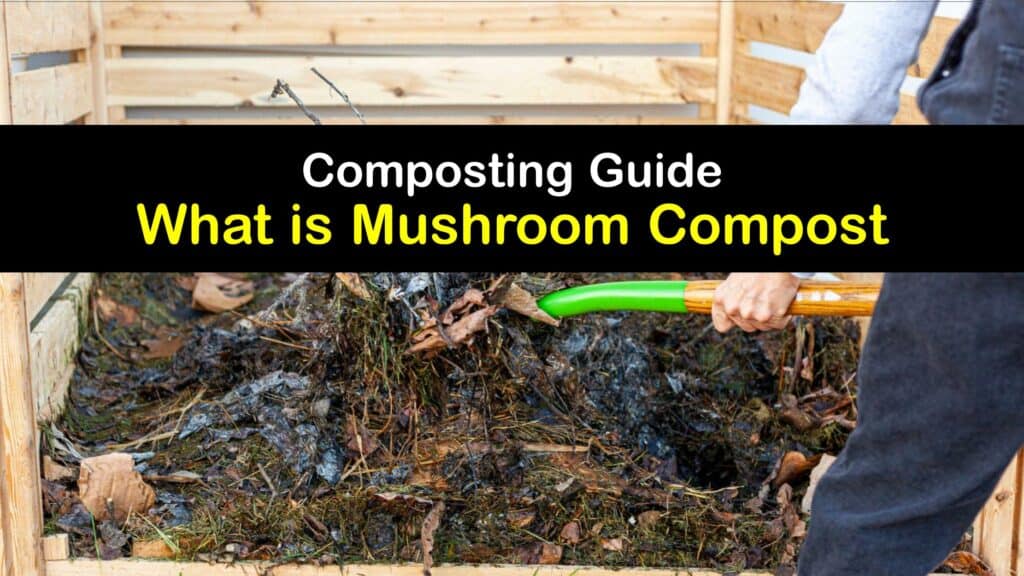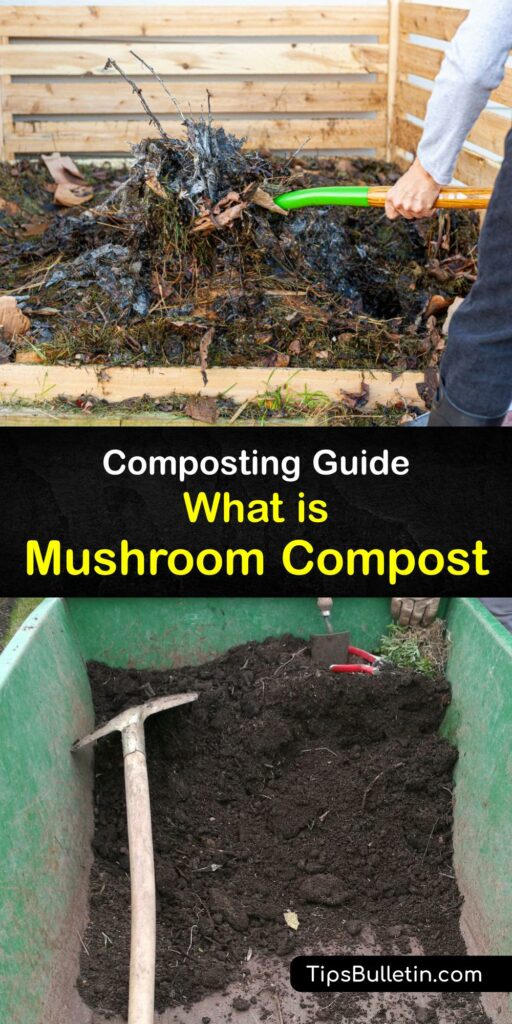Composting is an excellent way to convert leftover scraps from the kitchen and yard into usable materials for your lawn and garden soil. Finished compost is a soil conditioner, and it encourages healthy plant growth. You’ve probably heard about regular compost, manure compost, or worm compost, but what is mushroom compost?
Not many are as familiar with mushroom composting as they are with other forms of compost. However, organic mushroom compost is a great alternative, especially if you’re a mushroom grower. It’s the process of turning organic matter, like corn cobs, peat moss, poultry manure, and straw, into rich fertilizer.
Mushroom compost slowly releases nutrients into the dirt to improve soil health and give plants what they need to thrive. Find mushroom compost at nursery centers in bags labeled as spent mushroom compost or spent mushroom substrate. Yet, it’s easy to make this organic compost at home in a few simple steps.

Make and Use Mushroom Compost in the Garden
Mushroom compost is an organic material useful for providing your vegetable garden with the necessary nutrition. However, it’s vital to pasteurize it first to kill weed seed and harmful agents to ensure you get healthy finished compost.
Learn the many benefits this compost offers, how to make ericaceous compost and mushroom compost, and how compost will benefit the garden. Additionally, discover tips for creating mock mushroom compost to reap the same results with less effort.

What Is Mushroom Compost?
While there are some similarities, mushroom compost is slightly different from traditional compost. Explore what it is and how it differs from other popular compost materials.
You will also need to learn about plants that don’t like mushroom compost so that you can be sure to always use the best compost for the job.
Mushroom Compost
Unlike regular compost that results from combining greens and browns, spent mushroom compost is the growing medium resulting from the mushroom growing process. It’s sometimes called spent mushroom substrate and is made from hay, gypsum, chicken manure, wheat straw, and other agricultural materials.
What Are the Advantages of Mushroom Compost?
One of the main advantages of using mushroom compost is that the material is natural and safer for the environment. Learn about other compost benefits and why it’s a good choice for home-growers.
Mushroom compost contains phosphate, nitrogen, potassium, magnesium, iron, and calcium. It enriches the soil with the nutrients necessary for plant root, stem, and leaf growth. Additionally, planting in mushroom compost decreases the amount of watering required since it improves the soil’s water-holding capacity.
How to Make Mushroom Compost
The mushroom composting method varies slightly, depending on the mushroom grower. Yet, the process is relatively simple. Discover simple methods to start composting with mushrooms in the home compost bin.
Start by combining soil, straw, manure, edible mushroom trimmings, and mushroom bacteria or spores in the compost bin. After mushrooms have gone bad you can add them to your compost bin; you don’t need to use fresh mushrooms. Allow the material to sit for one to two months as the pile heats up and the bacteria feeds on the manure and straw.
Harvest the growing mushroom and let the heap continue to process while staying at a temperature of 140°F to achieve pasteurization. Turn the pile every few days for about a month to allow the material to break down further. When it’s done pasteurizing, let the compost cool before using it so that its temperature is the same as the ambient air.
Making Mock Mushroom Compost
A mock compost pile is ideal if you don’t want to go through the steps to prepare organic mushroom compost. Prepare mock compost as a substitute for mushroom compost.
Mix 20 percent manure with 40 percent soil and straw until the ingredients combine thoroughly. Water the materials to ensure they are moist and not soggy. Cover the compost with a tarp if you expect rain.
Turn the pile at least five times at two-week intervals, ensuring that the center of the pile heats up well. If the heap doesn’t get warm, add a little more manure. Heat is necessary for killing unwanted microbes and bacteria.
After turning the heap five times, cover it with a tarp and let it age for at least a month before using the compost. The longer you let it age, the safer it is for your tomato plants and vegetable patch.
How to Use Mushroom Compost in the Garden
Mushroom composting is complete after a few weeks, and you can finally utilize the finished compost. Determine how to use mushroom compost in the garden and reap all that it has to offer.
Fresh mushroom compost is an excellent soil amendment for a lawn since it helps the dirt hold water, decreasing the lawn’s watering needs. It’s also ideal for working into a bed to reduce heavy soil and creating nutrient rich potting soil for a container plant.
However, caution is necessary since young plants and salt sensitive plants, like rhododendrons and azaleas, cannot tolerate mushroom substrate. Additionally, it can kill a germinating seed, and it’s best to use seed-starting soil instead when starting plants from seed.
To use mushroom soil in the garden, mix it thoroughly into the dirt before planting or let it rest over the winter and spread it in the spring. When container gardening, combine one part compost with two parts soil before planting. For lawn use, spike the ground for aeration and spread a uniform half-inch layer of the compost over the surface.
While each mushroom farmer has their own recipe for composting mushrooms, the process is relatively straightforward. Pasteurize the compost pile, add mushroom spawn, top dress with organic matter, and you end up with fertilizer in a matter of weeks.

What is mushroom compost is a common question. Knowing how to make and use mushroom compost at home goes a long way in the garden, so why not share our mushroom farming and composting guide with your friends and family on Pinterest and Facebook?